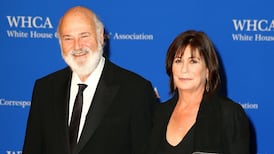One of the more surprising things a middle-age running habit has taught me is that there may be at least some truth in the crackpot theories of De Selby, the mad scientist and philosopher from the novels of Flann O’Brien.
I'm thinking in particular of his idea about roads being essentially one-directional, even when, on the surface, they appear to lead two ways. "A good road," he is quoted as saying in The Third Policeman, "will have character and a certain air of destiny, an indefinable intimation that it is going somewhere, be it east or west, and not coming back from there".
Of course you can choose to travel against this psychic topography. It’s just not advisable. “If you go with such a road,” says De Selby, “it will give you pleasant travelling, fine sights at every corner and a gentle ease of peregrination that will persuade you that you are walking forever on falling ground. But if you go east on a road that is on its way west, you will marvel at the unfailing bleakness of every prospect and the great number of sore-footed inclines that confront you...”
This reflection occurs as an aside to The Third Policeman's unnamed narrator: a man who has devoted his life to studying the idiot-savant, as a result of which he is now in hell. It's a strangely pastoral hell, however, devoid of fire and not unpleasant.
As critics have noted, its geography may have been inspired by the countryside around Tullamore, where O’Brien spent childhood years.
That too conforms with my running experiences. For not only have I become convinced that certain Irish roads are indeed meant to be followed in only one direction, but also that these seem to be more common in the midlands, where they tend to host popular road races, for the obvious reason that good times (in the chronometrical sense at least) are guaranteed.
It’s not just a question of organisers plotting a downhill course, from A to B. That would be easy.
For logistical reasons, however, most mass athletic events have to finish where they started, more or less. So courses must be looped, on roads leading out of and then back into a town or village.
This being so, any descents should be counterbalanced by climbs, or so you would think.
But in my experience, there are routes in Dunboyne, Kilcock, and Johnstown Bridge, to name three, that are straight out of De Selby’s warped textbook. I’m also hearing great things about Kinnegad, where there’s a race next week.
These routes are all deep in countryside, and all seem to fall away gently and continuously, each new turn of the road a pleasant surprise, until one final surprise, the finish line, which occurs earlier than expected. Then you’re back where you began. And yet it couldn’t work in the opposite direction.
It seems to be a common factor in such places, by the way, that the routes are anti-clockwise. In this, they follow the universal convention of athletics tracks, whereon events always run in only one direction.
Why should that be? Why should it not vary from meeting to meeting, or country to country, as in, say, horse-racing? The English Grand National and Derby both go anti-clockwise, for example.
The Irish equivalents, naturally, go the other way. But not in track athletics. There, turns are always right to left.
Among the reasons I’ve heard advanced for this is that the human heart is on the left side and that the flow into it of deoxygenated blood is assisted by the centrifugal force exerted by turning anti-clockwise. Hence the direction of all running tracks since ancient times, not to mention merry-go-rounds, circus-animal routines, even the Mexican Wave.
The theory seems almost worthy of De Selby. And being nonsense, it is. I’m told by those who know that the only reasons track-races are always anti-clockwise are that (a) most people are right-footed and (b) tradition.
Further proof that there is no medical reason for it may be the forthcoming Liberties Fun Run in Dublin, which I’ve been asked to mention.
Taking place on July 18th, it will raise funds for a good cause, gynaecological cancer care at St James Hospital (supportstjames.ie).
But it’s a four-mìle loop of Dublin 8’s best-known streets. And although as usual, the more serious participants will be competing against the clock, that will apply to the route. Direction-wise, I’m told, everybody will be going with the clock on this occasion.










